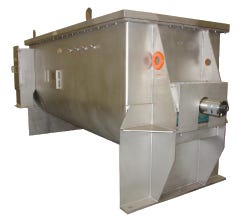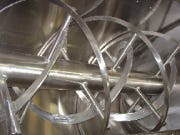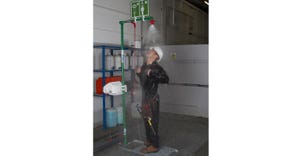Specifying a Solids Blender
March 6, 2007
|
Short-residence-time continuous mixer |
From the basic blending of two similarly sized powdered materials to the blending of several different ingredients to form functional blends, mixers have a wide variety of possible applications. Because they can be used in myriad ways, mixers come in many styles to meet different needs. This article addresses some of the questions that users should ask and options they should consider when selecting a mixer for their applications.
It is always best to start by defining the objectives of the installation:
• How many ingredients are being blended?
• Are the powders similar in size and density?
• Are liquids being added to the blend?
• What production rate is required for the system?
After answering some preliminary questions, it is time to dig a little deeper. Would it be advantageous to combine several process steps into one? Some mixers allow heating or cooling while mixing, which enables users to avoid an additional step. Other mixers combine mixing and agglomeration or mixing and drying in one unit. Many options are available. In addition, because the mixer is generally only one part of a complete system, it is critical to determine how it will interact with the rest of the process.
Another important consideration is whether the material must be specially handled. If the material poses an explosion risk, users will want to ensure that the equipment can be purged and contained. If the material poses a health hazard, the equipment must be dusttight to prevent worker exposure.
Another question to consider is whether a batch or a continuous mixing system makes the most sense for the facility in question. The general characteristics of each system are listed below.
Batch Systems. In batch systems, bad lots are easily identified. Extra labor is required when batches are switched. Batch systems are most appropriate for low production rates. They are better suited for intermittent production and appropriate for frequent product changeovers. Generally, there is less equipment to clean in batch systems if frequent system cleanouts are required.
|
Batch ribbon blender capable of long residence times |
Continuous Mixing Systems. Continuous systems can provide a more uniform product than batch systems. They require less labor and are better suited to high production rates. They are good for applications that involve few expected shutdowns. Continuous mixing systems are used to manufacture one or very few different products and are appropriate when equipment is stopped and cleaned infrequently.
Pharmaceutical applications often use batch operations in which full accountability for each lot is required. Commodity chemicals are most often manufactured using continuous processes to achieve the lowest production costs.
In processes that require many ingredients, batch blending is the most appropriate option to lower the number of feeders required. Alternatively, in a continuous-blending system, many minor ingredients can be preblended to form a single feed.
If the particle sizes of the solid ingredients are quite different, segregation can become an issue. Some batch blenders do not overcome segregation, or they result in a homogenous blend that resegregates during discharge. Using a continuous blender can alleviate these issues as long as the product is used after blending rather than stored in an intermediate hopper.
When segregation is difficult to avoid, agglomeration can be used. By forming larger agglomerates with the correct ratio of ingredients, the blend is stabilized. Some mixers can be used to form agglomerates simply by adding an appropriate amount of a liquid binder while blending. When agglomeration is used, the resulting granules often require drying.
Residence time can vary quite widely from one type of mixer to another. The type of mixer that a company selects depends on whether its mixtures require residence time in a blender to achieve hydration or other chemical reactions.
|
A mixer’s polished interior can be cleaned in place. |
Abrasive materials can cause equipment wear. High-speed or high-shear blenders experience more wear than slow-speed, low-shear mixers. However, even high-speed mixers can be used in abrasive applications. Mixers can be manufactured with thicker bodies for longer life, or they can include replaceable wear-resistant liners. A variety of wear-resistant coatings are also available.
In the case of heat-sensitive materials, temperature increases during mixing should be investigated. High-shear mixers tend to raise the temperature of the material as a result of friction. Some mixers offer optional cooling units such as water jackets.
If a company manufactures food or pharma-grade products or frequent product changeovers occur, the cleanability of the mixer is important. Easy access to the internals and a more-polished finish are generally available options in such cases. Quick disconnects result in faster disassembly. Some units offer clean-in-place (CIP) options while others must be completely disassembled by hand to ensure complete cleaning.
Once a company has a clear picture of what is required, it can begin to narrow down its equipment choices. In many cases, bench- and pilot-scale testing of the blending process is recommended. Most equipment suppliers run pilot test facilities that customers can use to run material on the actual equipment. Pilot testing confirms the viability of the mixers under investigation and yields data that are used to achieve accurate scale-up to production-sized equipment.
After equipment testing, the list of options can be further narrowed down by investigating the mixer’s operating requirements. Users should ask the following questions:
• What power consumption is expected?
• How much maintenance is required, and how frequently?
• What is the cost of the expected spare parts, and how readily available are they?
End-users should also look at a supplier’s reputation. Has it been in business for some time? Does the customer already have a relationship with the supplier from other projects? Does the supplier offer equipment field service or training?
With a rigorous evaluation of their process requirements, companies will be able to work more effectively with suppliers and select the best equipment for their processes.
Sara Gantner is an application engineer at Bepex International LLC, Minneapolis, MN. She can be reached at 585-419-6284 or [email protected].
About the Author(s)
You May Also Like







